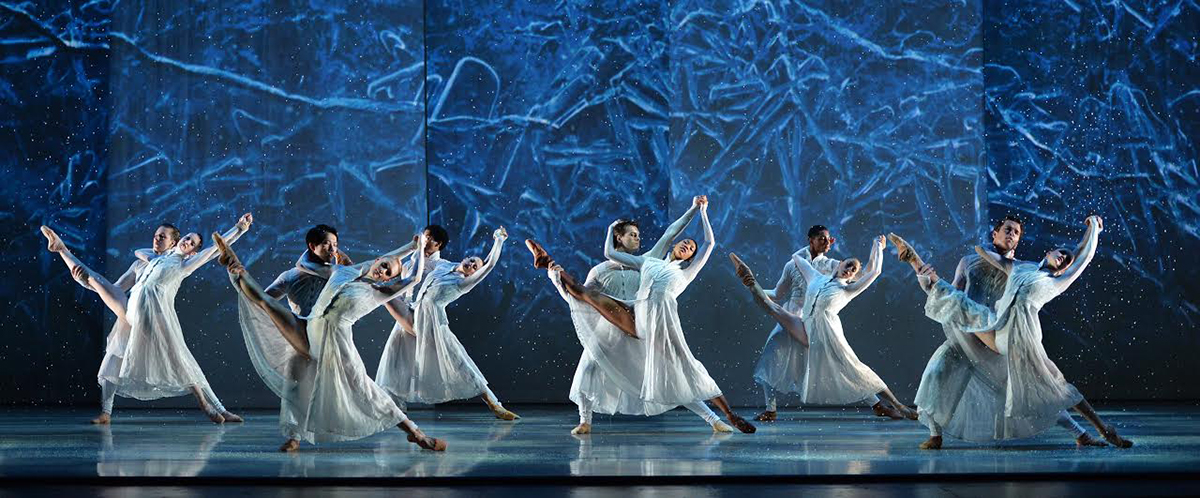To conclude this week’s theme of “Pushing Our Bodies’ Limits,” the Charlotte Ballet in Residence and Chautauqua Symphony Orchestra will push themselves even further.
At 8:15 p.m. August 12 in the Amphitheater, the two groups will come together to present three ballets.
When bringing music and dance together, it can present some challenges.
Patricia McBride, master teacher and repetiteur, will be staging George Balanchine’s “Rubies”, which comes from a larger ballet called Jewels. McBride was the original lead of the ballet in its 1967 creation. The original ballet include two other parts: “Emeralds” and “Diamonds.” Each section has its own personality.
“It was such a wonderful, unusual full-length ballet linking the three jewel sections,” McBride said. “It’s still going strong. It’s being performed … all over the world.”
The dancers have had to do a little adjusting in the last week of rehearsals after James Kopecky broke his nose during the Dance Innovations performance, said Jean-Pierre Bonnefoux, artistic director. He will not be performing in the evening’s dances. Josh Hall, another Charlotte Ballet dancer, injured his foot in the week leading up to tonight’s performance.
Due to the injuries, Alessandra Ball James and Alexander Peters will perform the principal leads and Sarah Lapointe will perform the role of the “tall girl” in “Rubies.” Peters is a principal dancer with the Pennsylvania Ballet.
McBride enjoys passing down the work and doesn’t expect anybody to perform as she would have.
“I don’t want them to be me,” McBride said. “I want them to be the best that they can as themselves. Many dancers have done it all over the world and they’re very different than the way I’ve danced it. But what doesn’t change is the musicality — the intent of the choreography is at the base, the most important thing. The intent of Balanchine, the way he would choreograph [is] with a musical intent. That’s what I hope to impart. They will bring their own artistry to it.”
Conductor Grant Cooper said “Rubies” does not have a direct narrative, such as “Swan Lake” or other traditional 19th-century ballets tend to have, but rather an “implied narrative or an emotional evolution.”
The idea of the title Rubies, Cooper said, invites the audience to use their imaginations.
“[Today’s ballets] are conceived in the same kind of nebulous world that music is,” Cooper said. “So you can’t really say that a piece of symphonic music is about something.”
Several students will perform in the corps de ballet. McBride said the dancers, from the principal role to the corps, benefit greatly from performing a Balanchine work.
“It’s a lot of fun,” McBride said. “It’s an endurance race. It’s a … lot of stamina for the principals and a lot of joy. You can really get into the steps with the musicality. You really learn the score, what it is, with Mr. Balanchine’s choreography.”
“Reflections (of a Life)” by Mark Diamond, Chautauqua Dance faculty member, will open the evening with music by Gustav Holst, the inspiration behind the choreography.
The ballet is performed en pointe and depicts more of a narrative but with some abstract characters. It shows the memories of a woman, whose mother’s critical habits have been passed along to her.
“It’s like a cycle that wasn’t broken,” Diamond said.
It was originally choreographed with Ball James and she will be performing it again tonight.
“I’m so happy to see her do it again because she’s an amazing dancer, technically and dramatically,” Diamond said. “She’s so good at details that it’s really the same [as the original], if not better.”
Tonight is the first time all four of Sasha Janes’ ballet “Four Seasons” will be performed in Chautauqua. Janes, a Chautauqua Dance faculty member, said he’s also having some School of Dance students take part in his ballet.
Cooper said the group’s short rehearsal period requires every part of the performance to be prepared before the two groups collaborate.
The instrumentalists can prepare individually, Cooper said, but the dancers have to prepare by working off each other because they are working in a physical space relative to each other with movements that are relative to each other.
“We worry about how a musical phrase comes out, but we don’t worry so much how a person uses the physicality of their technique to achieve that musical phrase,” Cooper said. “With the dance, I think the way one moves from point A to point B, which is the beginning of a phrase to the end of a phrase, is a very important part of what the dance is. It’s the journey that is important.”
When the CSO and the Charlotte Ballet meet to combine their talents, Cooper said his job as conductor is to understand there will be some discrepancies for the dancers between a live performance and a recorded performance.
Audience members often inquire, Cooper said, about whether it is better for the dancers to have live music or recorded music.
“The obvious point of view that most people understand is that there has got to be some benefit to the music always being the same, which it is when you use a recording and which it rarely is when you don’t use a recording,” Cooper said. “But interestingly, in a twist of logic, while certain things are easier to do when you know exactly what the tempos are going to be, there is an energy that comes from performing in a collaborative manner with live musicians.”
Janes said with listening to the recording so often, the live version can seem very different.
“It’s always a wonderful experience with the CSO,” Janes said. “It’s interesting because of what they can they do in the recording. They sound really full, so I’m always a little surprised that it’s often smaller sounding than what I’m used to. But it’s still a beautiful experience to have the CSO playing. It’s amazing. The hardest part is always the tempo — if it’s too fast or too slow. We’ll have a few challenges, but I think it’s going to sound marvelous.”
The dancers are behind the orchestra with the horns closest to them, so they hear the back of the orchestra much louder than they hear the front of the orchestra. In practice, they rehearsed to a recording made from the front of the orchestra.
“And so it is actually a bigger adjustment than simply the tempos,” Cooper said. “It’s the whole sound of the orchestra and the whole nature of other human beings making a sound with his instrument or the collective orchestra playing, which just wraps around you in a completely different way than a recording does.”
Janes said tonight’s performance will give the audience a little bit of everything with the final performance of the season with the Charlotte Ballet.
“They’re going to have the quintessential master in Balanchine, so that’s going to be unforgettable because it’s being staged by Patricia McBride,” Janes said. “Then they’ve got Mark Diamond’s piece, which is more of an abstract narrative and a bit of a dark piece, but then hopefully with mine it’s just beautiful imagery of the dancers and what they’re able to do.”
McBride said it’s “wonderful” to have the CSO accompany the dancers.
“There’s nothing like a live performance with the orchestra,” McBride said. “Grant Cooper … has been coming to the rehearsals and watching. We’re so looking forward to our last show to have the last culmination with the orchestra and our dancers.”





